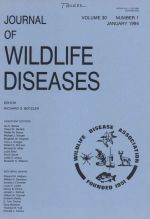Thirty-two juvenile green turtles (Chelonia mydas) were captured alive in Kaneohe Bay, Island of Oahu, Hawaii, during September 1991. Ten of the turtles sampled were afflicted with green turtle fibropapillomatosis (GTFP) in varying degrees of severity. Virus isolation attempts were negative in all individuals. Using nasopharyngeal and cloacal swabs, we isolated 28 Gram negative bacteria, five Gram positive cocci, Bacillus spp., and diphtheroids. The most common isolates included Pseudomonas fluorescens (68%), P. putrefaciens (66%), Vibrio alginolyticus (50%), non-hemolytic Streptococcus (50%), V. damsela (47%), and V. fluvialis (47%). Chlamydial antigen was detected in four of the turtles sampled. The primary lesions in animals with GTFP were hyperplasia of squamous epithelial cells and mesodermal proliferation with a marked degree of orthokeratotic hyperkeratosis. Mites, leeches, and other organisms were associated with the surface of papilloma lesions. The etiologic agent of GTFP was not isolated.
How to translate text using browser tools
1 January 1994
EVALUATION OF HAWAIIAN GREEN TURTLES (CHELONIA MYDAS) FOR POTENTIAL PATHOGENS ASSOCIATED WITH FIBROPAPILLOMAS
A. Alonso Aguirre,
George H. Balazs,
B. Zimmerman,
Terry R. Spraker

Journal of Wildlife Diseases
Vol. 30 • No. 1
January 1994
Vol. 30 • No. 1
January 1994
bacteriology
Chelonia mydas
disease survey
fibropapillomas
green turtle
Hawaii
histopathology




